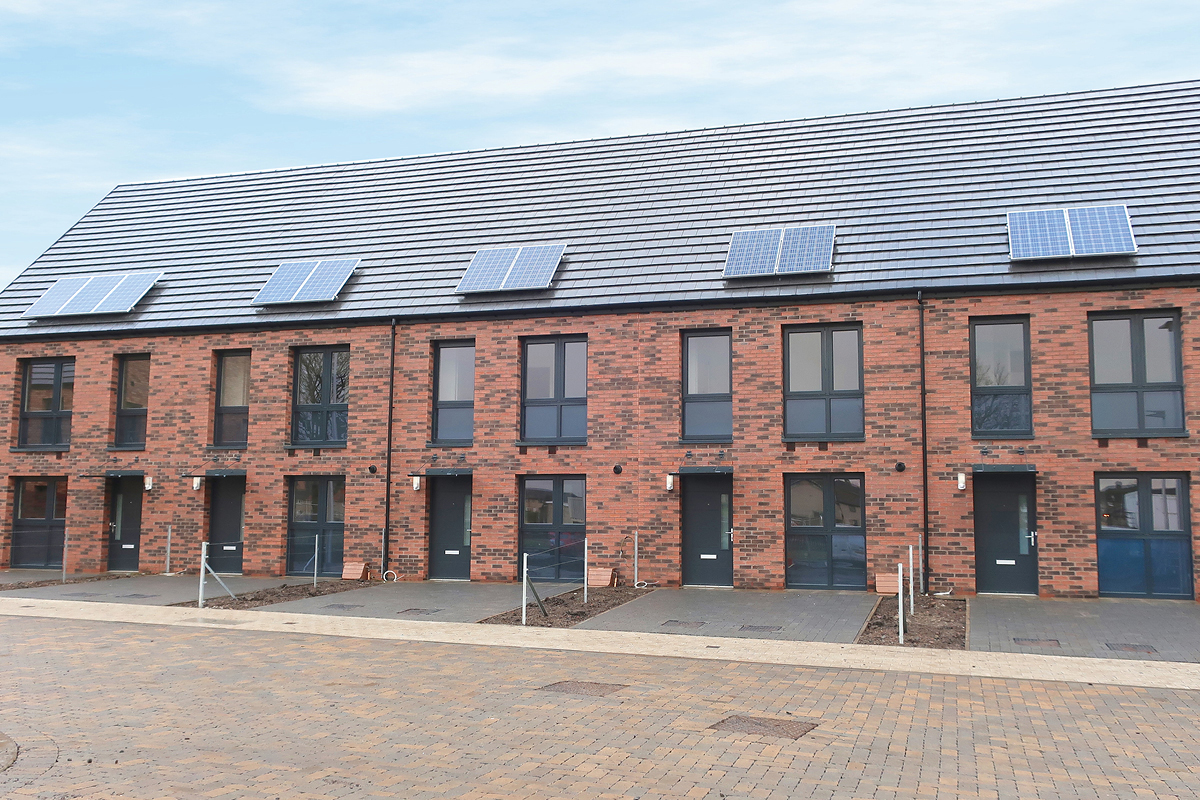You are viewing 1 of your 1 free articles
Scotland’s housebuilding boom: can English councils emulate it?
Scotland is in the midst of the biggest council housebuilding programme since the 1970s. With the borrowing cap now lifted for English local authorities, Michael Lloyd asks whether they will be able to emulate the Scots’ progress. Illustration by The Boy Fitz Hammond
Scotland is midway through its most ambitious social housebuilding programme in a generation, with local authorities in the vanguard of planning and construction.
The £3bn, five-year plan to build 50,000 affordable houses – 35,000 of which will be for social rent – is the culmination of more than a decade of investment to improve the country’s social housing stock.
During the year up to September 2018, 1,507 of the 4,919 houses built for social rent in Scotland were council houses, the outcome of a local authority building revival that began as far back as 2007. In that year, three councils around Edinburgh – Midlothian, East Lothian and West Lothian – set out plans for 5,000 houses.
Two legal changes have helped to fuel this Scottish revival
“We are one of the smallest local authorities in Scotland, yet we are building more council houses than the whole of London,” the late Adam Montgomery, former leader of Midlothian Council, claimed in Inside Housing at the time. Of the 1,000 Midlothian homes promised, 864 were delivered by 2014. That’s not quite as many as the 1,530 council houses that the London boroughs built between them from 2007 to 2014, but an impressive feat when you realise that the capital has around 80 times Midlothian’s population.
Two legal changes have helped to fuel this Scottish revival. The Right to Buy was restrained north of the border by the Housing (Scotland) Act 2001, with all new council house sales stopped between 2007 and 2009. It was abolished completely after 2016. Second, debt restrictions on councils were loosened under the ‘prudential borrowing’ regime of the Local Government in Scotland Act 2003.
The Right to Buy was curtailed in England as well, under the last Labour government, but policy began to diverge sharply with Scotland after the 2010 election. David Cameron’s government increased Right to Buy discounts, while Scottish National Party-led Scotland headed down the road of abolition.
A similar divergence is evident with local authorities’ borrowing limits. English authorities didn’t have the borrowing freedom allowed in Scotland, and limits were tightened further by the government in 2012. Theresa May has now relaxed the rules – but has she done enough to help English councils catch up?
They may have some way to go. Government figures show that Scotland built only slightly fewer council houses than England did in 2017/18, but with one-tenth of the population. There were 1,960 completions in England and 1,588 in Scotland.
This policy divergence between the two countries has philosophical roots, according to Professor Ken Gibb of the University of Glasgow. He thinks that Scotland’s policymakers – perhaps for ideological reasons – place a stronger emphasis on social housing.
The language used by the National Performance Framework, which sets out the Scottish government’s overall objectives, is an indication not only of different priorities but also of its attitude to housing, Professor Gibb believes. “They [the Scottish government] are saying that housing should not be seen just as a stock of wealth – more as a consumption good for everybody.
“The performance framework emphasises that stable house prices should be a goal – that is quite different. It is thinking more about the system as a whole, focusing more on the shelter aspects of housing rather than its use as an asset.”
Both council and housing association providers are building homes for rent and affordable ownership. The current affordable housing programme is the second phase. In 2012 the Scottish government launched its first major programme, to deliver 30,000 houses by 2015.
The 30,000 target was achieved, allowing the government to up its ambition to 50,000 for the current programme. According to a Shelter study last year, it is on track to deliver a minimum of 45,387 and a maximum of 49,773 units.
A key stimulus has been grant funding for local authorities to build alongside housing associations – though at slightly less generous rates. Associations receive £70,000 for most three-occupant social properties, while councils get only £57,000.
A recent report from the UK Collaborative Centre for Housing Evidence, of which Professor Gibb is director, highlights another distinctively Scottish feature: building for mid-market rent. The pivot towards mid-market rent was laid out in the latest phase of the Scottish government’s affordable building programmes.
“There is a significant shift [in the current plan] towards grant-funded mid-market rent and away from affordable homeownership, which is a critical difference in supply policy at the margin compared with England,” the report claims.
How have Scottish councils taken advantage of this apparently favourable housebuilding environment?
One of the most proactive local authorities is Fife, where head of housing John Mills is proud of his council’s achievements. The council is working in partnership with four Fife-based housing associations and has 3,500 new homes planned by 2022, 1,500 of them council houses.
Mr Mills thinks the Scottish government’s agenda is ambitious and challenging. “If we are going to build record numbers of houses in social and affordable tenures… and get people flowing through the homelessness system much more quickly, we’ve got to have a steady supply,” he says.
Although conditions for building council houses have been more favourable in Scotland over the past decade, storm clouds are looming on the horizon
The Fife partnership had already constructed 1,300 council houses and 2,700 affordable homes in total under the previous 2012-15 housebuilding programme. Mr Mills agrees that, while the prudential borrowing regime freed councils to help fund housing projects, the restriction and the abolition of the Right to Buy have also been crucial.
“It was pure economics,” he elaborates. “There was little point in our investing over £125,000 in a property and after a period of time having to sell at a significant discount.
“You are not able to get the rental income you need over a 30-year mortgage, for example, if you are having to sell at Right to Buy discount. The rest of the tenants and the Housing Revenue Account have to pick up the tab.”
Although conditions for building council houses have been more favourable in Scotland over the past decade, storm clouds are on the horizon. And Brexit is the most threatening. Mr Mills is worried that many EU nationals are already going home, potentially sucking skilled Scottish workers to London to fill the gaps.
He continues: “The major house builders operating in Fife have UK interests, so if there is enhanced competition for that labour force that will be an issue for all parts of the UK, not least Scotland… If you can’t get skilled labour coming in at the right rate for projects, that really restricts the pace at which you can build housing.”
In numbers: Scottish house building
- 50,000 - The number of affordable homes Scotland plans to build in its current 5-year plan
- 1,588 - Total council house completions in Scotland in 2017/8
- 1,960 - Total council house completions in England in 2017/8
- £57,000 - grant available to Scottish councils for a three-occupant social property
Source: Scottish government statistics
There are also concerns about land supply. “Fife’s Housing Revenue Account has used up much of the land bank it had accumulated over a generation,” explains Mr Mills. “Another aspect is trying to work with all the public agencies so that any surplus land assets are offered up for affordable housing developments.”
Land and skills shortages are a UK-wide problem, but for English local authorities other issues may stand in the way of emulating the Scottish experience.
David Enticott, director of Derby Homes, the ALMO owned by Derby City Council, has concerns about the rules for using Right to Buy receipts and the level of sales discounts. But he is upbeat about the borrowing cap lift and thinks it will make it easier to build.
“Absolutely everybody welcomes this change because it just removes an artificial constraint, really. It allows local people to manage the balance of local debt to delivery,” Mr Enticott says.
"Now we can simply sit down and plan out, over a number of years, a more realistic longer-term strategy that will still be prudent" David Enticott, Derby Homes
Derby Homes and the city council are discussing how best to make use of their new-found financial freedom. Derby already had plans to invest its Right to Buy income but now it can take a broader perspective.
“Previously we had to stay within our borrowing cap and we were within £9m of that, which limited total capacity. Now we can simply sit down and plan out, over a number of years, a more realistic longer-term strategy that will still be prudent,” he explains.
He agrees with Mr Mills in Fife that land and skills capacity are live issues, but he is optimistic that councillors will not see building new homes as wasteful because they might be sold.
“Elected members are very supportive of new social housing. Of course the Right to Buy is still hanging about there, so it’s going to be an interesting debate when we have it.”
The issue will be debated at many councils, according to Steve Partridge, director at Savills Housing Consultancy. But he thinks that constraints on selling new build will be sufficient reassurance for many. New houses cannot be bought at less than the construction cost for the first 15 years (and not at all for the first three) and discount is restricted.
“Yes, it’s a barrier no doubt… but most authorities would take the view that between the cost floor and the discount there’s unlikely to be many Right to Buys in the short to medium term,” Mr Partridge claims.
A Savills report last year criticised the borrowing cap and called for its abolition, to make it easier for councils to reach their government-set target of replacing Right to Buy sales one for one. Mr Partridge now expects to see growth in partnerships between housing associations, councils and private builders, across wide areas, to take advantage of the more liberal borrowing regime. “I am very optimistic now that one of the major restraints has been removed,” he says.
But Professor Gibb is more cautious. Lifting the borrowing cap may not go far enough. “I think it remains to be seen. It is a necessary condition but not a sufficient condition.”
He says new council housing sits among a range of local housing company initiatives, which are already doing a lot of good. But he thinks more decisive action should be taken on reducing the negative impact of the Right to Buy. Providing a sufficient level of grant funding in England will be key to success, as well.
Mr Partridge believes that there is now the political will at UK government level to stimulate developments. “Homes England is very keen to get agreements with registered providers and local authorities to get homes built… it’s the number one priority of this government… so I think there are good opportunities for local authorities to engage with Homes England to get grant,” he explains.
It took nearly a decade for Scottish councils to take full advantage of more favourable conditions to return to housebuilding at scale. And those conditions are still more favourable than in England.
Emulating the Scots’ example south of the border, it seems, may be neither quick nor easy.















